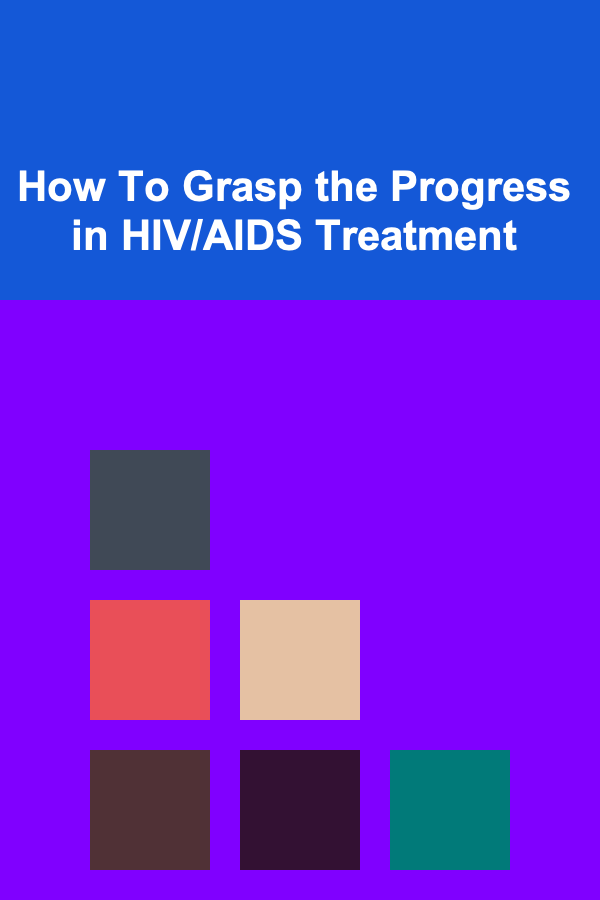
How To Grasp the Progress in HIV/AIDS Treatment
ebook include PDF & Audio bundle (Micro Guide)
$12.99$10.99
Limited Time Offer! Order within the next:

Human Immunodeficiency Virus (HIV) and Acquired Immune Deficiency Syndrome (AIDS) have long been among the most significant global health challenges. Since the identification of HIV in the early 1980s, the disease has claimed millions of lives, caused widespread fear, and posed profound medical and social challenges. However, significant advances in treatment have transformed HIV from a fatal disease into a manageable chronic condition for many people living with the virus. This article explores the progress made in HIV/AIDS treatment, focusing on scientific advancements, treatment protocols, challenges faced, and future directions.
The Journey of HIV/AIDS Treatment: From Death Sentence to Chronic Condition
1. Early Days of HIV/AIDS: The Beginning of the Epidemic
When HIV was first identified, it was a death sentence. In the early 1980s, the medical community had little understanding of the virus and its progression. Those infected with HIV would often develop AIDS, which marked the final stage of the disease. AIDS is characterized by a severely weakened immune system, leaving the body vulnerable to opportunistic infections and certain cancers.
The early response to the epidemic was not just medical but social and cultural, with stigma surrounding HIV, primarily associated with the LGBTQ+ community, drug users, and individuals involved in sex work. At this point, the virus was essentially untreatable, and the median survival time after the onset of AIDS was often just one to two years.
2. The Discovery of HIV and Initial Breakthroughs
The discovery of HIV as the cause of AIDS came in 1983, when researchers at the Pasteur Institute in France identified the virus, which was later named HIV (Human Immunodeficiency Virus). This discovery marked a critical turning point in understanding the disease's transmission and pathology.
The first significant advancement in treatment came in the form of antiretroviral therapy (ART), which emerged in the 1990s. ART works by targeting the virus at various stages of its lifecycle. Initially, the therapy was not widely available and was often toxic to patients, but it proved to be a lifeline for those who could access it.
3. The Emergence of ART and the "AIDS Cocktail"
In 1996, the introduction of highly active antiretroviral therapy (HAART) , often referred to as the "AIDS cocktail," revolutionized HIV treatment. HAART combined multiple antiretroviral drugs that worked together to suppress viral replication. This combination therapy, which included drugs like protease inhibitors and nucleoside reverse transcriptase inhibitors (NRTIs), helped reduce viral loads to undetectable levels in many patients.
This breakthrough turned HIV from a fatal disease into a manageable one for many individuals. Patients on HAART could now live longer, healthier lives, and HIV/AIDS became a chronic illness rather than an immediate death sentence. The introduction of ART also significantly reduced the transmission rates of HIV, particularly with the use of pre-exposure prophylaxis (PrEP).
Understanding the Mechanism of HIV and How Treatments Work
4. HIV Pathophysiology: How the Virus Attacks the Immune System
HIV attacks and destroys CD4 T cells, which are critical to the immune system's ability to fight infections. The virus enters these cells, replicates, and ultimately destroys them. As the number of CD4 cells decreases, the body's immune system becomes weakened, making individuals more susceptible to opportunistic infections and cancers.
The clinical progression of HIV can be broken down into several stages:
- Acute HIV Infection: This stage occurs within 2-4 weeks of exposure to HIV, during which individuals may experience flu-like symptoms. The virus replicates rapidly, but the immune system begins producing antibodies to fight the infection.
- Chronic HIV Infection: This is the asymptomatic stage that can last for many years. During this time, the virus continues to replicate in the body, albeit at a slower rate. If untreated, this stage progresses to AIDS.
- AIDS: This is the final stage of HIV infection, where the immune system is severely compromised, and individuals are highly vulnerable to infections and certain cancers.
5. Current Antiretroviral Therapy (ART)
The primary treatment for HIV today remains ART, which involves taking a combination of drugs that target different parts of the virus's lifecycle. ART doesn't cure HIV, but it suppresses the virus, reducing its ability to replicate and preventing damage to the immune system. There are several classes of ART medications, including:
- Nucleoside Reverse Transcriptase Inhibitors (NRTIs): These drugs block the reverse transcriptase enzyme, which is critical for HIV replication.
- Non-Nucleoside Reverse Transcriptase Inhibitors (NNRTIs): These inhibit reverse transcriptase by binding to the enzyme and preventing it from functioning.
- Protease Inhibitors (PIs): These block the protease enzyme, which is essential for HIV to mature and infect other cells.
- Integrase Strand Transfer Inhibitors (INSTIs): These inhibit the integrase enzyme, which HIV uses to integrate its genetic material into the host's DNA.
- Entry Inhibitors: These prevent HIV from entering the host cell in the first place.
A combination of these drugs works synergistically to suppress viral replication, with the goal of maintaining a undetectable viral load. With consistent adherence to ART, many people living with HIV can live long and healthy lives.
Challenges in HIV Treatment
6. Adherence to ART
One of the most significant challenges in managing HIV is ensuring adherence to ART. Although ART has proven effective, the regimen is often complex and involves taking multiple medications at different times of the day. Missed doses can lead to viral resistance, reducing the effectiveness of treatment.
Additionally, side effects of ART can discourage individuals from adhering to their treatment plans. Some common side effects include gastrointestinal issues, fatigue, and changes in metabolism. These side effects can be managed, but they remain a significant barrier to treatment for some individuals.
7. Viral Resistance
HIV can mutate rapidly, which means that the virus can develop resistance to certain drugs in ART regimens. If the virus becomes resistant to a medication, it can no longer be effectively suppressed by that drug, and a different regimen needs to be prescribed. Resistance is more likely to develop in people who miss doses or do not adhere to their prescribed therapy.
8. Access to Treatment
Another critical challenge is ensuring access to treatment for all individuals living with HIV, especially in low- and middle-income countries. While ART is widely available in many parts of the world, there are still significant disparities in access, particularly in rural or economically disadvantaged areas. According to the World Health Organization (WHO), approximately 38 million people were living with HIV worldwide in 2019, and more than 12 million of them were not receiving treatment.
9. Stigma and Mental Health Issues
Living with HIV still carries significant stigma in many societies. This stigma can lead to social isolation, discrimination, and mental health challenges for individuals living with the virus. These issues can, in turn, affect adherence to treatment and overall quality of life. The mental health aspect of living with HIV must be addressed alongside physical treatment to ensure comprehensive care.
The Future of HIV Treatment
10. Towards a Cure: Scientific Advances
Despite the success of ART, a cure for HIV remains elusive. However, research continues, and there have been some exciting developments in the search for a cure. These include gene editing techniques like CRISPR, which can potentially remove HIV from the DNA of infected cells. Early research in this area is promising, but much work remains before this technology can be used in clinical settings.
Another avenue of research is HIV remission . In recent years, there have been cases of individuals who have stopped ART and maintained undetectable viral loads for extended periods. These individuals are often referred to as being in "functional cure" or remission, though this remains rare and not yet reproducible on a larger scale.
11. Long-Acting ART
One of the most promising developments in HIV treatment is the introduction of long-acting injectable ART. These treatments can provide a sustained release of medication over weeks or months, reducing the need for daily oral medications. This would simplify treatment regimens and improve adherence, especially for individuals who struggle with daily pills.
12. Broadly Neutralizing Antibodies (bNAbs)
Another area of promising research is the development of broadly neutralizing antibodies (bNAbs), which are designed to target multiple strains of HIV. These antibodies can neutralize the virus and may one day be used as part of a treatment regimen or even as a preventive measure to reduce the risk of infection.
13. HIV Vaccines
The ultimate goal of HIV research is the development of an effective vaccine. While many vaccines have been tested over the years, no HIV vaccine has yet been successful in providing long-term protection. However, there is renewed hope in the field, and several vaccine candidates are currently in clinical trials.
Conclusion: The Road Ahead
The progress made in HIV treatment over the past few decades is nothing short of remarkable. From a fatal disease with little hope to a manageable chronic condition, the advancements in HIV treatment have saved millions of lives. However, there is still much work to be done. Overcoming challenges like adherence to treatment, viral resistance, and access to care remains a priority.
As research into a cure continues, and with the promise of long-acting ART, gene editing, and potential vaccines, the future of HIV treatment holds great promise. While we may not yet have a cure, the relentless pursuit of scientific advancements and the growing global commitment to addressing HIV/AIDS offer hope that one day, we will be able to end the epidemic and provide a better quality of life for those living with the virus.

How to Organize Social Media Promotions for Volunteer Events
Read More
How to Organize Your Closet to Save Space and Avoid Clutter
Read More
How to Refinance Your Student Loans for Better Interest Rates
Read More
The Art of Marketing Management: Leading Teams and Growing Brands
Read More
How To Master Hand Management in Card Games
Read More
How to Plan a Themed Cooking Class (Italian, Mexican, etc.)
Read MoreOther Products

How to Organize Social Media Promotions for Volunteer Events
Read More
How to Organize Your Closet to Save Space and Avoid Clutter
Read More
How to Refinance Your Student Loans for Better Interest Rates
Read More
The Art of Marketing Management: Leading Teams and Growing Brands
Read More
How To Master Hand Management in Card Games
Read More